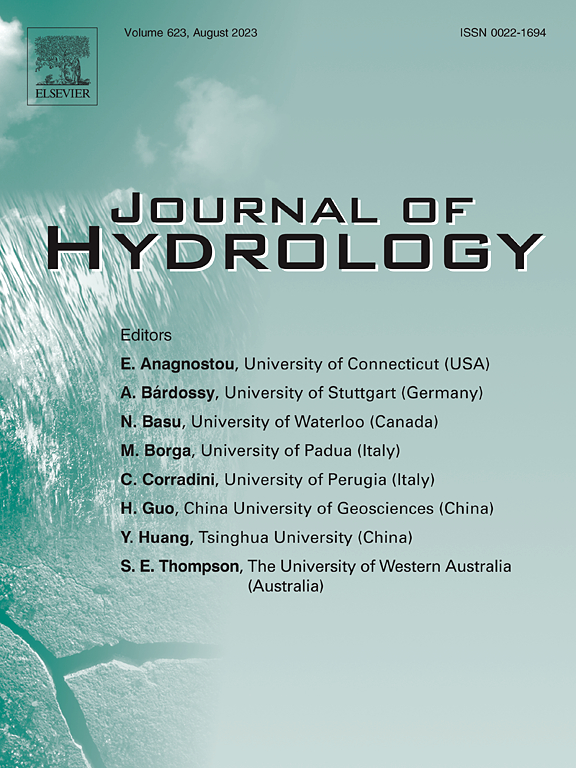DRSTF: A hybrid-approach framework for reservoir water temperature forecasting considering operation response
IF 5.9
1区 地球科学
Q1 ENGINEERING, CIVIL
引用次数: 0
Abstract
Reservoir water temperature forecasting typically relies on meteorological factors as inputs and often overlooks the influence of reservoir operation. Moreover, the accuracy of reservoir water temperature forecasting and dispatch management is limited by poor-quality samples and the effective capturing of relevant information. In this study, we propose a Dimensionality Reduction and Simulation Training Framework (DRSTF) that generates training data using CE-QUAL-W2 (W2). Using the maximal information coefficient and an autoencoder, the framework reconstructs significant patterns of reservoir water temperature influenced by meteorological and operational factors from historical data (7 days preceding the target date). This process guides machine learning models for forecasting reservoir water temperatures. Three schemes (simulation accuracy, training scale, and reservoir operation scenario) were built to analyze the performance of the DRSTF. The results show that: (1) DRSTF performance is slightly affected by the accuracy of the simulation samples, and simulation training can attain forecasting precision comparable to observation training; (2) DRSTF exhibits a low training size requirement; compared to training with all samples (731 days), the mean absolute error (MAE) value when training on a limited number of samples (73 days) increases by only 10.8 %; and (3) DRSTF successfully forecasts the water temperature distribution, with the MAE reaching 0.266 °C, influenced by flood season reservoir scheduling. The proposed DRSTF can overcome constraints related to the quality, quantity, and dimensionality of hydrological and meteorological data, thereby achieving efficient forecasting of reservoir water temperatures, while accounting for the influence of reservoir operation.
DRSTF:考虑运行响应的水库水温预报混合方法框架
水库水温预报通常依赖气象因素作为输入,往往忽略了水库运行的影响。此外,水库水温预报和调度管理的准确性受限于劣质样本和相关信息的有效捕捉。在本研究中,我们提出了一种降维与模拟训练框架(DRSTF),该框架利用 CE-QUAL-W2 (W2) 生成训练数据。该框架利用最大信息系数和自动编码器,从历史数据(目标日期前 7 天)中重建受气象和运行因素影响的水库水温的重要模式。这一过程为预测水库水温的机器学习模型提供指导。建立了三种方案(模拟精度、训练规模和水库运行情况)来分析 DRSTF 的性能。结果表明(1) DRSTF 的性能受模拟样本精度的影响较小,模拟训练可达到与观测训练相当的预报精度;(2) DRSTF 对训练规模的要求较低;与使用所有样本(731 天)进行训练相比,使用有限样本(73 天)进行训练时,平均绝对误差(MAE)值仅增加 10.8%;(3) DRSTF 成功预报了水温分布,受汛期水库调度的影响,MAE 达到 0.266 ℃。所提出的 DRSTF 可以克服与水文和气象数据的质量、数量和维度有关的限制,从而在考虑水库运行影响的同时实现对水库水温的高效预报。
本文章由计算机程序翻译,如有差异,请以英文原文为准。
求助全文
约1分钟内获得全文
求助全文
来源期刊

Journal of Hydrology
地学-地球科学综合
CiteScore
11.00
自引率
12.50%
发文量
1309
审稿时长
7.5 months
期刊介绍:
The Journal of Hydrology publishes original research papers and comprehensive reviews in all the subfields of the hydrological sciences including water based management and policy issues that impact on economics and society. These comprise, but are not limited to the physical, chemical, biogeochemical, stochastic and systems aspects of surface and groundwater hydrology, hydrometeorology and hydrogeology. Relevant topics incorporating the insights and methodologies of disciplines such as climatology, water resource systems, hydraulics, agrohydrology, geomorphology, soil science, instrumentation and remote sensing, civil and environmental engineering are included. Social science perspectives on hydrological problems such as resource and ecological economics, environmental sociology, psychology and behavioural science, management and policy analysis are also invited. Multi-and interdisciplinary analyses of hydrological problems are within scope. The science published in the Journal of Hydrology is relevant to catchment scales rather than exclusively to a local scale or site.
 求助内容:
求助内容: 应助结果提醒方式:
应助结果提醒方式:


